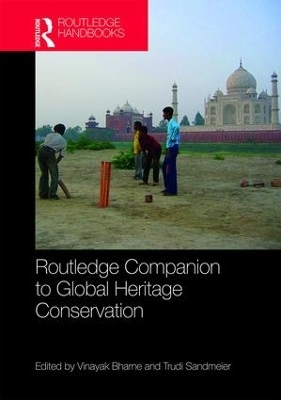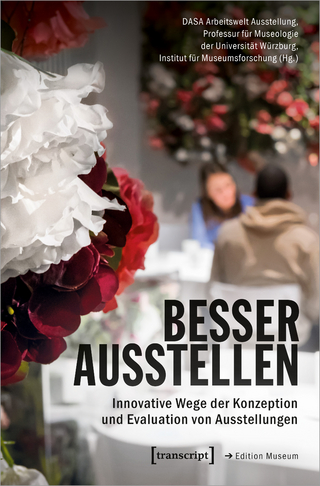
Routledge Companion to Global Heritage Conservation
Routledge (Verlag)
978-1-138-96298-9 (ISBN)
How and where do such aspirations overlap and differ across nations and societies across the world? In places with different histories, governance structures, regulatory stringency, and populist dispositions, who are the specific players, and what are the actual processes that bring about bigger and deeper change beyond just the conservation of an architectural or urban entity of perceived value?
This collection of scholarly articles by theorists, academics, and practitioners explores the global complexity, guises, and potential of heritage conservation. Going from Tokyo to Cairo, Shenzhen to Rome, and Delhi to Moscow, this volume examines a vast range of topics – indigenous habitats, urban cores, vernacular infrastructure, colonial towns, squatters, burial sites, war zones, and modern landmarks. It surfaces numerous inherent issues – water stress, deforestation, social oppression, poverty, religion, immigration, and polity, expanding the definitions of heritage conservation as both a professional discipline and socio-cultural catalyst. This book argues that the intellectual and praxis limits of heritage conservation – as the agency of reading, defining, and intervening with built heritage – can be expansive, aimed at bigger positive change beyond a specific subject or object; plural, enmeshed with multiple fields and specializations; and empathetic, born from the actual socio-political realities of a place.
Vinayak Bharne is Adjunct Associate Professor of Urbanism and Heritage Conservation at the University of Southern California, USA, and Principal and Director of Design at the architecture and urban design firm Moule & Polyzoides, USA. His books include The Emerging Asian City: Concomitant Urbanities & Urbanisms (2012), Rediscovering the Hindu Temple: The Sacred Architecture and Urbanism of India (2012), and Zen Spaces & Neon Places: Reflections on Japanese Architecture and Urbanism (2013). Trudi Sandmeier is the Director of Graduate Programs in Heritage Conservation and an Associate Professor of Practice in Architecture at the University of Southern California, USA. Her work centers on the conservation of the recent past and efforts to make visible the impact of underrepresented constituencies on the historic built environment.
Preface & Acknowledgements
Introduction: Global Perspectives in Heritage Conservation by Vinayak Bharne & Trudi Sandmeier
SECTION 1 – GLOBALIZING THE CONSERVATION DISCOURSE
Re-examining World Heritage and Sustainable Development by Sophia Labadi (University of Kent)
Re-conceptualizing ‘historic urban landscapes’ by Kalliopi Fouseki (University College London)
Earthquakes and Afterlives: Heritage Conservation and Seismicity by Elizabeth Aitken Rose (University of Auckland)
Beyond Nostalgic Appeal - The Means and Measures Dictating Heritage Management Trends in Pakistan by Noman Ahmed and Anila Naeem (NED University of Engineering & Technology, Pakistan)
Formal Order Out of Informal Chaos – a New Latin American Dialogue between the Official Practice of Heritage Conservation and the Concept of Self-Organization by Jaime Correa (University of Miami)
SECTION 2 – RE-EVALUATING AN AGING PAST
Towards an integrative and empathetic heritage conservation: The Case of Kandy, Sri Lanka by Kapila D. Silva (University of Kansas)
Rural Cultural Landscapes and the Purposes of Heritage - the case of the Cultural Landscape of Bali Province (Indonesia) by Kristal Buckley, Deakin University (Australia)
Continuing Culture and Meeting Modernity: The World Heritage Villages of Shirakawa-Gō and Gokayama, Japan by Rana P.B. Singh (Banaras Hindu University)
Visioning Cultural Heritage and Planning: Banaras, the Cultural Capital of India by Rana P. B Singh & Pravin s. Rana (Banaras Hindu University)
Natural, Cultural, and Heritage Landscapes: Intersections of authenticity, preservation, landscape, and heritage in rock art conservation by Kristin Barry (Ball State University)
SECTION 3 – EMBRACING AN UNDERESTIMATED HERITAGE
Revaluing Industrial Heritage: Transformation of the Port District in Nantes, France by Ann Borst (Wentworth Institute of Technology)
Accumulating Memory: The Shenzhen Value Factory by Eric Schuldenfrei (University of Hong Kong)
From obsolete military infrastructure to public space: the evolving identity of Latvia’s Riga Central Market by Mia Bennett (University of California Los Angeles)
The Once and Future Dingbat: Conserving Dingbats’ Future will Require Redressing their Past by Elizabeth Faletta (University of Southern California)
Dwelling in Possibility? A Case Study of Deep Heritage Conservation: Liverpool’s Temple of Humanity by Matthew Wilson (Ball State University)
SECTION 4 – BALANCING NATIVE & FOREIGN
Ritual Practice and Place Conflict: Negotiating a Contested Landscape along Jamaica Bay by Alison Hirsch (University of Southern California)
Modern Infrastructure and Historic Urban Landscape: Re-Evaluating Local Conservation Practices in Light of Hanoi’s Metro Project by Huê-Tâm Jamme (University of Southern California) and Floriane Ortega
Chinatowns as Territorial Trope: A Case Study of Vancouver, San Francisco and Los Angeles by Mari Fujita (University of British Columbia)
Theming as a preservation tool? On the authenticity of Thames Town, the English village of Shanghai by Maria Francesca Piazzoni (University of Southern California)
Designs upon Jerusalem: Bezalel Academy occupies the historic Russian Compound by Christopher Pokarier & Erez Golani Solomon (Waseda University)
| Erscheinungsdatum | 28.02.2019 |
|---|---|
| Zusatzinfo | 20 Line drawings, black and white; 105 Halftones, black and white |
| Verlagsort | London |
| Sprache | englisch |
| Maße | 174 x 246 mm |
| Gewicht | 1043 g |
| Themenwelt | Kunst / Musik / Theater |
| Reisen ► Reiseführer | |
| Geisteswissenschaften ► Geschichte ► Hilfswissenschaften | |
| Sozialwissenschaften ► Soziologie ► Spezielle Soziologien | |
| Technik ► Bauwesen | |
| ISBN-10 | 1-138-96298-8 / 1138962988 |
| ISBN-13 | 978-1-138-96298-9 / 9781138962989 |
| Zustand | Neuware |
| Informationen gemäß Produktsicherheitsverordnung (GPSR) | |
| Haben Sie eine Frage zum Produkt? |
aus dem Bereich


